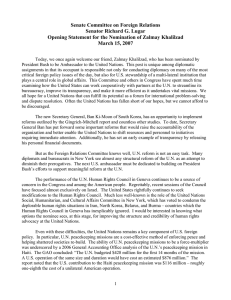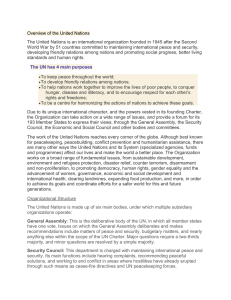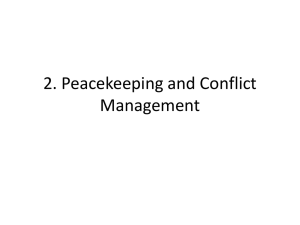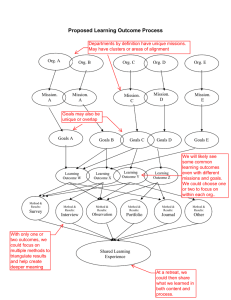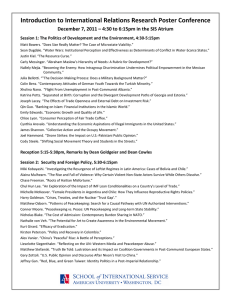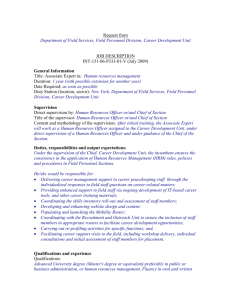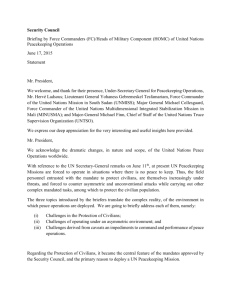Document 14671240
advertisement
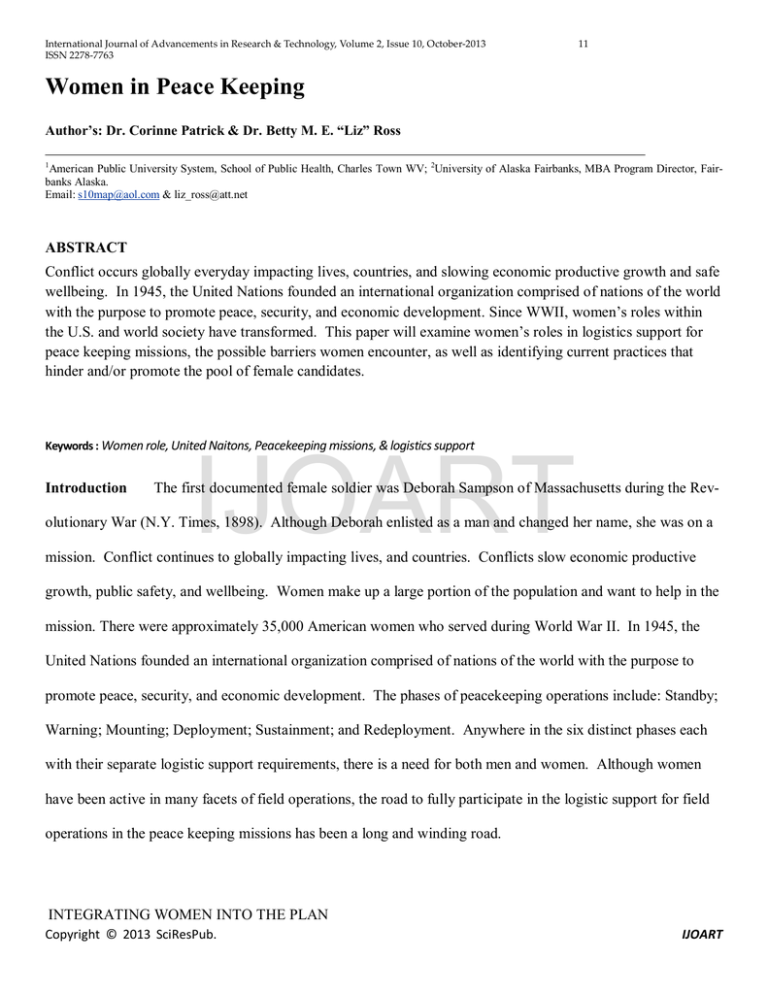
International Journal of Advancements in Research & Technology, Volume 2, Issue 10, October-2013 ISSN 2278-7763 11 Women in Peace Keeping Author’s: Dr. Corinne Patrick & Dr. Betty M. E. “Liz” Ross 1 American Public University System, School of Public Health, Charles Town WV; 2University of Alaska Fairbanks, MBA Program Director, Fairbanks Alaska. Email: s10map@aol.com & liz_ross@att.net ABSTRACT Conflict occurs globally everyday impacting lives, countries, and slowing economic productive growth and safe wellbeing. In 1945, the United Nations founded an international organization comprised of nations of the world with the purpose to promote peace, security, and economic development. Since WWII, women’s roles within the U.S. and world society have transformed. This paper will examine women’s roles in logistics support for peace keeping missions, the possible barriers women encounter, as well as identifying current practices that hinder and/or promote the pool of female candidates. IJOART Keywords : Women role, United Naitons, Peacekeeping missions, & logistics support Introduction The first documented female soldier was Deborah Sampson of Massachusetts during the Rev- olutionary War (N.Y. Times, 1898). Although Deborah enlisted as a man and changed her name, she was on a mission. Conflict continues to globally impacting lives, and countries. Conflicts slow economic productive growth, public safety, and wellbeing. Women make up a large portion of the population and want to help in the mission. There were approximately 35,000 American women who served during World War II. In 1945, the United Nations founded an international organization comprised of nations of the world with the purpose to promote peace, security, and economic development. The phases of peacekeeping operations include: Standby; Warning; Mounting; Deployment; Sustainment; and Redeployment. Anywhere in the six distinct phases each with their separate logistic support requirements, there is a need for both men and women. Although women have been active in many facets of field operations, the road to fully participate in the logistic support for field operations in the peace keeping missions has been a long and winding road. INTEGRATING WOMEN INTO THE PLAN Copyright © 2013 SciResPub. IJOART International Journal of Advancements in Research & Technology, Volume 2, Issue 10, October-2013 ISSN 2278-7763 Since the inception of the United Nations, 12 in its International Development Strategy. Some re- there have been issues about women and about the searchers and practitioners made it a central topic of equality between women and men in the operation. debate on development, especially after the publica- The primary task of the Charter of the United Nations tion of Ester Boserup's pioneering book, Women's is to protect the rights and freedoms of every human Role in Economic Development. Women’s roles in the being regardless of race, sex, language, or religion. stability operations literally became a field of study, The Preamble to the Charter affirms the equal rights of advocacy, and somewhat of a practice in its own right men and women as well as faith in fundamental hu- throughout the 1970’s. man rights and the dignity and worth of the human person. At the Fourth World Conference on Women held in Beijing in 1995, the focal point became the IJOART During 1961-1970 this was known as the De- transforming of the initiatives in order to achieve gen- velopment Decade for the United Nations. It was dur- der equality. Rather than equality in access to re- ing this time that the status of women was not a major sources, the politics of gender relations and restructur- topic of concern (1999 UN Report). “Although the ing of institutions was the goal for program develop- General Assembly mandated the Commission on the ment. [Note: For a more elaborate discussion of the Status of Women in 1962 to prepare a report on wom- conceptual shifts in the women-and-development dis- en's role in development, the focus of the Commission course, and the alternative categorization of the two was mainly on the humanitarian aspects of develop- approaches, see Moser (1993) and Razavi and Miller ment and on women's legal rights, rather than the mul- (1995).] tifaceted aspects of women and development” (1999 UN Report, para. 11). In the following decade (1971-1980), attention The 1990’s brought yet another shift. There was a political rather than economic aspects of development became the focus of concern for the gender to the role of women intensified. The General Assem- and development arena. Now women were to take the bly included the integration of women as an objective initiative as equal partners in a participatory and "bot- Copyright © 2013 SciResPub. IJOART International Journal of Advancements in Research & Technology, Volume 2, Issue 10, October-2013 ISSN 2278-7763 13 tom-up" process of development. In this approach, various parties, including Member States, the Secre- "Empowerment cannot be given, it must be self- tary-General, the Council and parties to armed conflict generated. All that a gender-transformative policy can as applicable, to hope to do is to provide women with enabling resources which will allow them to take greater control 1. Gender mainstream UN peacekeeping operations; of their own lives, to determine what kinds of gender relations they would want to live within, and to devise the strategies and alliances to help them get there" (Kabeer, 1995, p. 97). So the idea was that transformative change presupposes the empowerment of women (1999 U.N. General Assembly). 2. Increase women’s representation and participation in decision-making processes before, during, and after conflict; and 3. Consider women’s specific needs in conflict and post-conflict operations, including by har- IJOART monizing national laws with international human rights standards. RESOLUTION 1325 The decade leading up to the adoption of Resolution 1325 saw the passing of many broad-based thematic resolutions which addressed general issues The Women’s International League for Peace and Freedom, part of the United Nations office was proud to announce: related to international peace and security. The resolutions on thematic issues of peace and security were known as ‘TIPS’. TIPS included resolutions based on a role for various entities or individuals outside the UN’s state-based system, such as parties involved in armed conflict, negotiators of peace agreements, etc. Resolution 1325 is a TIPS resolution that calls upon Copyright © 2013 SciResPub. On 31 October 2000, the United Nations Security Council (UNSC) unanimously adopted Resolution 1325 on women, peace and security. Resolution 1325 marks the first time the Security Council addressed IJOART International Journal of Advancements in Research & Technology, Volume 2, Issue 10, October-2013 ISSN 2278-7763 the disproportionate and unique impact of armed conflict on women, recognized the under-valued and under-utilized contributions women make to conflict prevention, peacekeeping, conflict resolution and peace-building, and stressed the importance of their equal and full participation as active agents in peace and security. 14 CURRENT EFFORTS OF WOMEN IN STABILITY OPERATIONS In March of 2008 a conference was held in Kigali. Discussions were focused on how to increase women’s participation in peacekeeping missions, and how these missions can work to prevent and respond rapidly to sexual and gender-based violence (SGBV). The conference falls under a wider program, funded by the UK Department for International Development (DFID), to strengthen the work of the Rwanda De- IJOART Resolution 1325’s adoption was a culmination of fense Forces (RDF) in combating SGBV, with particu- many years of efforts towards integrating women’s lar focus on building the capacities of the Gender issues into peace building and conflict studies and all Based Violence Desk at Ministry of Defense head- dimensions of the work of the United Nations. quarters and at decentralized levels. In the year following the endorsement of Reso- Since its launch in September 2007, the pro- lution 1325, the 2001 statistics for military women gram has trained 2,594 officers and cadets at the train- serving in the armed forces of North Atlantic Treaty ing academy, including 573 RDF officers preparing Organization (NATO) countries indicated an average for peacekeeping missions, ex-combatants, local de- of 5.5%. Since then, the numbers have increased; fense forces, and opinion leaders on the prevention however, not at a rate that will meet the efforts that are and response to SGBV. outlined by the organization. The organization is striving for the 50/50 balance by the year 2015. It was noted during the conference that “Women can improve the effectiveness of peacekeeping operations for the simple reason that they are not men” Copyright © 2013 SciResPub. IJOART International Journal of Advancements in Research & Technology, Volume 2, Issue 10, October-2013 ISSN 2278-7763 15 also according to Professor Gerard DeGroot of St. leadership in peace operations and post-conflict recon- Andrew’s University, Scotland, research has shown struction. that women exhibit unique levels of self-control in violent situations that have important applications to peacekeeping. In late 2006, the Department of Peacekeeping Operations (DPKO) disseminated a policy directive on Gender Equality in UN Peacekeeping Operations that In November 2006, 75 experts gather in New reiterates the necessity of increasing women’s civilian York and Washington to discuss “United Nations Re- and military roles in field missions. The DPKO also form: Improving Peace Operations by Advancing the released a Global Action Plan on 1325 that includes Role of Women.” This was convened by the Stanley the increased participation of women in peacekeeping Foundation and Women in International Security, as a priority for the agency. At the same time, UN IJOART practitioners and policymakers from various United member states are developing national action plans for Nations agencies, national governments and militaries, the implementation of Resolution 1325, which include academia, and civil society groups identified barriers increased recruitment of women for peace operations. to women’s advancement and generated concrete ways to improve the recruitment and selection of women for peace operations as heads of mission, military personnel, civilian police, and international and national staff. At the meetings experts convened in working groups to discuss the recruitment and retention of women in five categories of peacekeeping personnel: heads of mission, military personnel, civilian police, international civilian staff, and national civilian staff. It was noted that to respond appropriately to Participants outlined the process for hiring personnel, the growing need for stabilization operations, experts the challenges and opportunities to promote women, at the meetings recognized the need to draw upon a and practical recommendations for various actors in wide variety of personnel with diverse skills and ex- the five categories. pertise, including women, who can provide critical Copyright © 2013 SciResPub. CHALLENGES/BARRIERS FOR WOMEN IJOART International Journal of Advancements in Research & Technology, Volume 2, Issue 10, October-2013 ISSN 2278-7763 16 Critics have pointed out the slow and ad hoc nature of these efforts. Despite repeated mandates and policy commitments—and these initial actions just Other challenges to women’s recruitment and appointment include: described—little progress has been made to actually increase the number of women in peace operations. Statistics illustrate the implementation gap: • • formal job description. There are zero female heads of mission (out of 18 operations) and only one • woman deputy (Afghanistan). • Infrequent support by member states for women candidates, in part because they are required for national positions. Only 1 percent of military personnel IJOART are women (of 70,960 total troops). • An opaque hiring process without a • A lack of political will to appoint women from existing rosters of candi- Just 4 percent of police forces are dates despite the mandate for gender women (of 8,482 total police). balance in leadership. • Approximately 30 percent of international civilian staff are women (of • for women with such experience. 4,568 total)—a number that decreases to 10 percent in management positions at the D-1 level or above. • Women make up 22 percent of nationally recruited civilian staff (of 8,657 to- A variety of competing opportunities • A reluctance by some women to accept an appointment in war-torn countries with shifting time commitments as result of family concerns or obligations. tal), but many are relegated to service and clerical posts at the lowest grades. CONCLUSION AND RECOMMENDATIONS Copyright © 2013 SciResPub. IJOART International Journal of Advancements in Research & Technology, Volume 2, Issue 10, October-2013 ISSN 2278-7763 Aside from the challenges, it is clear that there is little advancement within the international peacekeeping environment to actively recruit women. It is evident, that there is a positive experience by utilizing women's participation, which can further enhance the various peacekeeping operations. In order to meet the 50-50 gender balance by 2015 strategies outlined in 17 sented by Colonel Leijenaar on 23 May 2000 at the NATO Headquarters in Brussels : The Committee on Women in the NATO Forces (CWINF) is the most powerful body of women in uniform. It should make itself known to the UN DPKO decision makers and get involved in UN PKOs at top levels. Some suggestions are: 2000 and each year thereafter should be followed. “It is my hope that the Security Coun- Establish contact with Military Advisers to the respective countries’ IJOART cil, Member States, the United Nations Permanent Missions to the UN in New system, the NGOs, civil society and others will take further decisive action to ensure the participation of women York. - and girls and fully incorporate their Identify posts and suitable women candidates for UN PK Missions. concerns into all our efforts to promote - Participate in the development of gender peace and security.” (S/2002/1/1154 dated training programmes. 16 Oct 2002) (The UN DPKO Training Unit for UN PK training in this regard will use Canada and UK’s effort). The following recommendations are from a presentation to the Committee on Women in NATO, pre- - Identify suitable female candidates to succeed the current NATO liaison officer who serves on DPKO's staff. Copyright © 2013 SciResPub. IJOART International Journal of Advancements in Research & Technology, Volume 2, Issue 10, October-2013 ISSN 2278-7763 - 18 Identify funds and suitable candidates for top appointments, especially for UN PK the approved senior gender analysis post at Missions. DPKO. - All UN PK Mission planning processes should include relevant gender issues. The UN might be the mirror image of its MS, - Gender mainstreaming in UN PK Missions but it also has the responsibility to set an example to must be institutionalised with the overall the international community it serves. The UN must responsibility placed with the SRSG. encourage the following: - The DPKO must ensure that all MS military environments have clarity regarding - the UN's gender perspectives. IJOART Political will and awareness has to be developed among top management to - The DPKO Training Unit must ensure that all training material includes gender promote gender mainstreaming. awareness training. - Competent women have to be included at the most senior levels of peace negotia- - Monitor and evaluation frameworks for Missions have to include gender perspec- tions. tives as an integral part. - Peace Agreements and Accords shall include gender perspectives. - Accountability mechanisms have to ensure that all personnel take responsibility for - UN PK Mission mandates explicitly ad- gender mainstreaming as relevant to their dress gender equality. - The UN has to develop an aggressive policy to identify and recruit senior women for Copyright © 2013 SciResPub. particular work. - Gender Units should be established in all major UN PK Missions. IJOART International Journal of Advancements in Research & Technology, Volume 2, Issue 10, October-2013 ISSN 2278-7763 - The UN should be cautious not to just "add numbers" to improve gender equality. - Gender sensitivity training should be con- - 19 Women must involve men in all their activities to promote gender equality and "buy in". tinued in UN Departments and PK Missions. - Coordinate and compose gender policies with UN PK to learn from the experience of other countries in integrating women in militaries. IJOART General recommendations: - "If we accept that in any society, gender equality is more than a goal in itself; if we believe that the empowerment of women is a vital means to meeting the challenge of sustainable development; if we argue that the participation of women is a requirement in building good governance; if we insist that the rights of women are a precondition for the effectiveness of humanitarian assistance; if we are convinced of all these things in relation to all the societies we are trying to help in this world - then how can we fail to apply this conviction to our own society in our own house?" (Kofi Annan 1998) More research, such as currently undertaken by DPKO's Lessons Learned Unit [LLU], regarding the involvement of military women in PKOs should be initiated. - The issue of military women and mentorship should be developed. - Military women should create viable networks. Copyright © 2013 SciResPub. IJOART International Journal of Advancements in Research & Technology, Volume 2, Issue 10, October-2013 ISSN 2278-7763 REFERENCES: 20 http://www.nationaldefensemagazine.org/issues/2005/ aug/US_Shifting.htm. Boutros Boutros-Ghali. (92/93 Winter). Empowering the United Nations. Retrieved June 30, 2008 from Kigali. (2008, March 26). Women Good for Peace http://www.foreignaffairs.org/19921201faessay5905/b Keeping Missions. Retrieved June 27, 2008 from outros-boutros-ghali/empowering-the-united- http://allafrica.com/stories/printable/200803260394.ht nations.html ml. Butty, J. (2006, October 31). Women Want More Leijenaar, A. (2002, November 5). Women’s Partici- Leadership Roles in UN Peacekeeping Missions. Re- pation in Peacekeeping Forces. Presentation Santiago, trieved July 6, 2008 from Chili. http://www.voanews.com/english/archive/2006- Stanley Foundation in cooperation with Women in 10/2006-10-31-voa11.cfm?renderforprint=. International Security (2006, Nov 14 NY and CWINF Guidance for NATO Gender Mainstreaming. Nov 16 Washington DC). United Nations Reform: (n.d.) Retrieved July 6, 2008 from Improving Peace Operations By Advancing the Role http://www.nato.int/issues/women_nato/cwinf_guidan of Women. Retrieved June 30, 2008 from ce.pdf. http://www.iknowpolitics.org/en/node/1175. Deborah Sampson. (1898, October 8). Deborah U.N. Development Fund for Women. (2008, April 1). Sampson: How She Served as a Soldier in the News: Kigali Conference Calls for More Women at IJOART All Levels of Peacekeeping Operations. Retrieved Revolution – Her Sex Unknown to the Army. New June 30, 2008 from York Times. http://www.unifem.org/news_events/story_detail.php? Kennedy, H. (2005, August). U.S. Shifting Forces to StoryID=665 U.N. General Assembly. (1999). 1999 "Stability Operations". Retrieved June 30, 2008 from World Survey on the Role of Women in Development: Copyright © 2013 SciResPub. IJOART International Journal of Advancements in Research & Technology, Volume 2, Issue 10, October-2013 ISSN 2278-7763 21 Globalization, Gender, and Work. Retrieved July 21, 2008 from http://www.unhchr.ch/Huridocda/Huridoca.nsf/0/053b 56b6ad21d1838025683f0059083a. UN-INSTRAW. (2006, December). Report on Attracting and Retaining Professional Women in Logistics Support for UN Peacekeeping Operations. Van Zeijl, F. (n.d.). Women in Blue Berets: U.N. mission addresses Congo violence – and gender equity. Retrieved Ms Magazine June 30, 2008 from IJOART http://www.msmagazine.com/spring2007/blueberets.a sp. Copyright © 2013 SciResPub. IJOART
